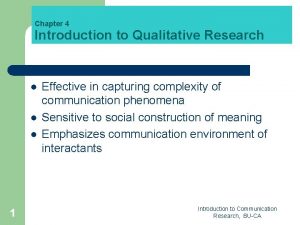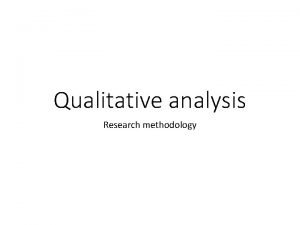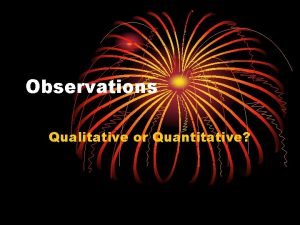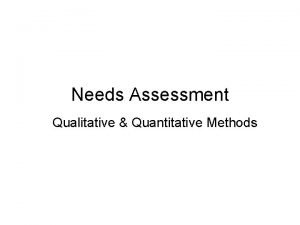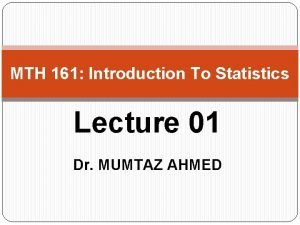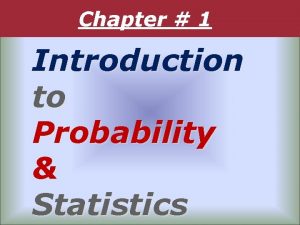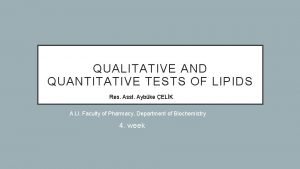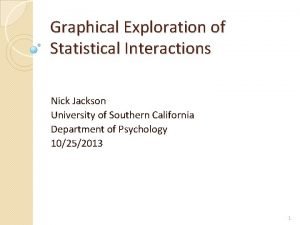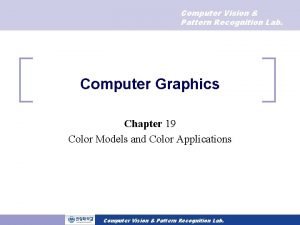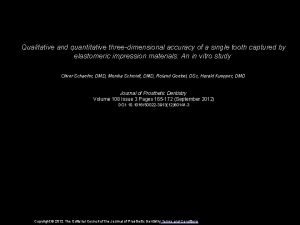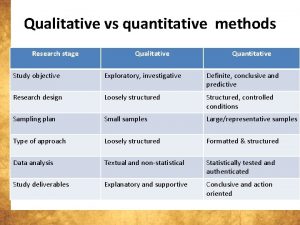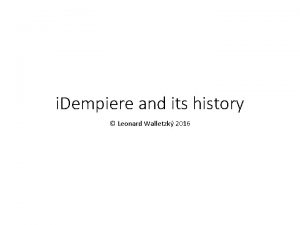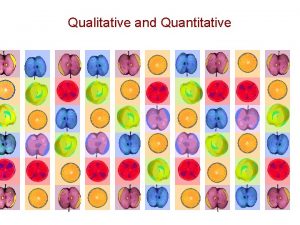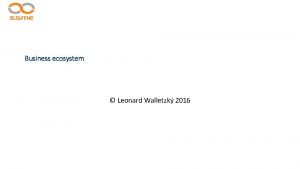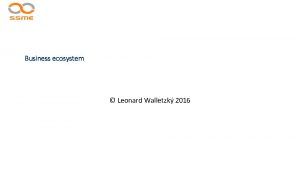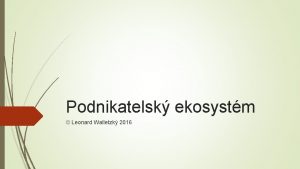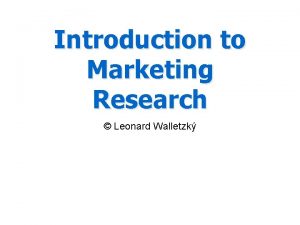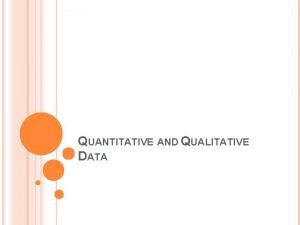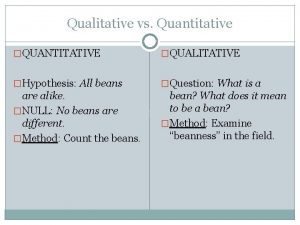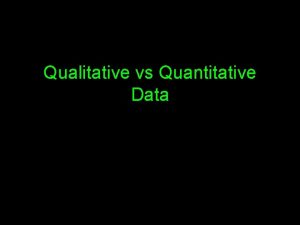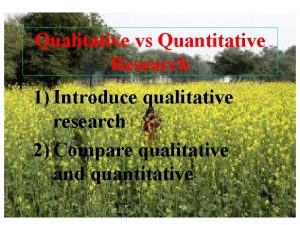Qualitative and Quantitative research II Leonard Walletzk 2016



























- Slides: 27

Qualitative and Quantitative research II © Leonard Walletzký 2016

Defining Marketing Research Identification of Information Needed • Identifying and Solving Marketing Problems Collection of Data Analysis of data Dissemination of Information Use of Information Název prezentace v zápatí 2

Identifying a research problem. Quantitative • Description of trends or an explanation of variables’ relationships. Qualitative • An exploration in which little is known about the problem. • A detailed understanding of a central phenomenon.

Reviewing the literature Quantitative Qualitative • Major role through suggesting the reporting questionnaire to be asked. • Justifying the responses problem and the need for the direction of the study. • Minor role in suggesting self regulating questionnaire (SRQ) to be asked. • Justify the importance of studying the research problem.

Specifying a purpose for the research Quantitative Qualitative • Be specific and narrow. • Seek measurable, observable data on variables. • Be general and broad. • Seek to understand the participants’ experiences

Collecting data Quantitative Qualitative • Collecting data using instruments with preset questions and responses • Collecting info from a large number of individuals. • Collecting data using forms with general, emerging questions to permit the participant to generate responses. • Gathering word(text) or image(picture) data. • Collecting info from a small number of individuals or sites.

Analyzing and Interpreting data Quantitative Qualitative • Data analysis tends to consist of statistical analysis. • Describing trends, comparing group differences, relating variables. • Interpretation tends to consist of comparing results with prior predictions and past research. • Text analysis. • A description of themes. • Stating the larger meaning of findings.

Reporting and Evaluating research Quantitative Qualitative • Tend to use standard fixed structure and evaluation criteria. • Take an objective and unbiased approach. • A flexible, emerging structure and evaluative criteria. • Take a subjective and biased approach.

Qualitative methods of marketing research Mystery shopping Focus group SERVQUAL In depth interview Observations

Mystery shopping Suitable for • Commercial organizations • State administrations • Public services Based on using fictive customers (mystery shoppers) with specific tasks to test Can be focused inside or outside the organization

Types of mystery Mystery Visits Mystery Buying Mystery Shopping of Retention Activities Complaint Mystery Shopping Mystery Delivery Mystery Calls and Emails • Inside real shops • Focused to evaluating level of staff and their skills • Focused to additional services and products • Offer of customers club, building relationship with customer • Focused to leaving customers • Testing of activity to preserve the customer • Measuring of the level of complaint service • The communication in case of unjustified complaint • The level of delivery services • Courier behavior • Document complexity • Number of calls, time of response • Form of communication • Identification of customer needs

Special mystery shopping Mystery Audit B 2 B Mystery Shopping Customer Journey Mystery Shopping • Equipment of actual leaflets and other materials • Preparedness of actual marketing campaign • Competitive Intelligence • Exploring competitive advantage • Dynamic approach to exploring quality of the service • Testing whole life cycle of the customer

Focus groups Basic data collection method Based on semi-structured group interview process Moderated by the leader The goal is to collect data on specific topic

Focus group – basic characteristic Standardization of questions • Focus groups can vary in the extent to which they follow a structured protocol or permit discussion to emerge Number of focus groups conducted • or sampling will depend on the 'segmentation' or different stratifications (e. g. age, sex, socioeconomic status, health status) that the researcher identifies as important to the research topic Number of participants per group • the rule of thumb has been 6 -10 homogeneous strangers, but there may be reasons to have smaller or slightly larger groups Level of moderator involvement • can vary from high to low degree of control exercised during focus groups (e. g. extent to which structured questions are asked and group dynamics are actively managed)

Focus group – working with data Recording • Audio or video recording • Transcribe group discussions • 2 – 3 researchers to take a notes • Importance of non-verbal data Benefits • To produce a large amount of data • Access to topics that might be otherwise unobservable • Provide access to comparisons that focus group participants make between their experiences.

SERVQUAL Based on contradiction between customer´s expectations and reality GAP model Working with gaps in the process of providing service • GAP 1 • What customer experts and what the management of the company assumes the customer expects • GAP 2 • Difference between features of the service • GAP 3 • Systems of delivery do not stand the proclaimed standards • GAP 4 • Company do not accomplish promised level of the service • GAP 5 • Sum of GAP 1 …. GAP 4

GAP Model Communication Personal needs Past experiences Expected service customer GAP 5 Perceived service Service communication Service delivery GAP 1 GAP 4 GAP 3 company Character of service GAP 2 Concept of service

In depth interview Is done by expert • psychologist The goal is to open the subject to wider communication To analyze the reason of the customer´s behavior Need to train the data collectors Specific sources of information • • Policy makers Project Staff Program Participants Community members

Observations Without direct contact between observer and subject observed Used if we need to collect registration information • Number of customers Observing, how many customers are buying particular item Using cookies in web browsers

Basic methods of observations Natural and Contrived Settings • Natural is exploring the natural life of the objects • In contrived setting the observer has created the setting for the research to take place. Distinguished and nondistinguished • If the objects know they are observed or not. Human and Mechanical • Done by humans or by technical equipment (like cameras) Direct and Indirect Structured and Unstructured • Direct is observing actual event. (How many customers are buying a cup of coffee) • Indirect is observing the results (Counting empty cups in the garbage) • If we have some categories of the observed data or we are simply recording everything

Quantitative methods examples CAPI • Computer-assisted personal interviewing CATI • Computer Assisted Telephonic Interview CAWI • Computer Assisted Web Interview Surveys In-hall test (CLT) • Central Location Test

Computer-assisted personal interviewing The interviewer uses his laptop screen to read the questions to pose and inputs the responses. Advantages Disadvantages • All types of questions can be used. • Material can be shown to the respondent. • Strong geographical constraint. • The CAPI is more adapted to reduced geographical areas. • Heavy cost.

Computer Assisted Telephonic Interview The interviewer asks questions by telephone and records answers on a computer. CATI automates the interviewees calls, the recall in case of absence and checks quota. Advantages Disadvantages • Quick • No geographical constraint • Technical reliability • Some target cannot be reached by CATI. • No visualization possibility. • Certain sensitive subjects must be avoided

Computer Aided Web Interviewing The CAWI questionnaire appears in the browser as a web-page that respondents can reach in different ways depending on the sample design Advantages • There are no print, interviewer and data input costs. • The collection time is reduced and there is no input time. • Real time processing. • No geographical constraint. • Suppression of skews due to the interviewer and input errors. • The respondents have all the time they want to answer the questionnaire. Disadvantages • The target is not representative of the national population • Professionalization and spontaneous self-recruitment of certain panelists. • Facility to quit the questionnaire. • Obligation to protect the data.

Surveys Specially trained Staff of marketing agency is doing a real time questionaries' Suitable for the long surveys with specified types of the subjects Typically used for • Measuring of opinions • Political preferences • Brand knowledge

Central Location Testing of special samples Respondents are recruited by trained Staff and motivated to complete survey Extremely expensive Can be used for • Testing of new features • Testing new brands or services • Comparing customers meaning of different products

Conclusion Differences in marketing research Examples of the each type of the research • Mystery shopping • Focus groups • GAP Model • Computer Support in Marketing Research
 Quantitative research examples
Quantitative research examples Qualitative vs quantitative
Qualitative vs quantitative Similarities between qualitative and quantitative research
Similarities between qualitative and quantitative research Similarities between qualitative and quantitative research
Similarities between qualitative and quantitative research Sampling methods in qualitative and quantitative research
Sampling methods in qualitative and quantitative research Examples of qualitative research
Examples of qualitative research Data analysis plan
Data analysis plan Methodology errors
Methodology errors Qualitative and quantitative data difference
Qualitative and quantitative data difference Example of quantitative observation
Example of quantitative observation Assessment is qualitative or quantitative
Assessment is qualitative or quantitative Qualitative variables and quantitative variables
Qualitative variables and quantitative variables Data analysis qualitative
Data analysis qualitative Types of quantitative variables
Types of quantitative variables Qualitative and quantitative test for lipids
Qualitative and quantitative test for lipids Observation qualitative or quantitative
Observation qualitative or quantitative Qualitative physical properties
Qualitative physical properties Qualitative and quantitative difference
Qualitative and quantitative difference Qualitative and quantitative difference
Qualitative and quantitative difference Hypothesis template
Hypothesis template Inheritance of quantitative traits
Inheritance of quantitative traits Quantitative and qualitative difference
Quantitative and qualitative difference Qualitative and quantitative
Qualitative and quantitative Quantitative and qualitative in chemistry
Quantitative and qualitative in chemistry Integrating qualitative and quantitative methods
Integrating qualitative and quantitative methods Quantitative and qualitative traits
Quantitative and qualitative traits Appendix sample
Appendix sample Chapter 3 research methodology sample quantitative
Chapter 3 research methodology sample quantitative



